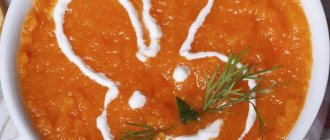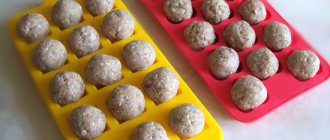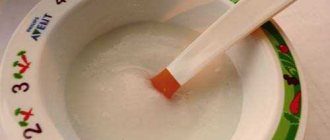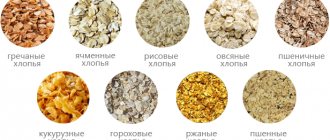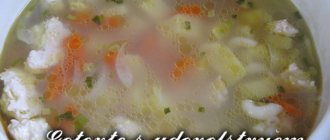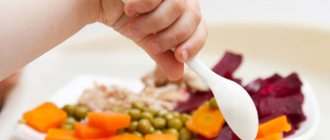Homemade soups are an integral part of any child’s diet. Experts believe that by the age of eight months, the baby’s digestive system has already been fully formed to digest liquid food. If the child is bottle-fed, you can offer him to taste the soup already at 6-7 months of age.
You should start complementary feeding with vegetable puree soups
Meatball soup
You will need:
- turkey fillet about 100 g.
- 30 g rice.
- One medium sized potato
- a quarter of an onion or a very small onion,
- 50 g cauliflower.
First you need to make minced turkey. Add half-cooked rice to the minced meat and form small meatballs. Drop them into boiling soup water and cook for about 10 minutes. Add potatoes, cut into small cubes, along with cabbage to the meatballs and cook for another 10 minutes.
Great soup recipe for an 8 month old baby!
Read - Turkey in feeding your baby.
Vegetable soup for children over 2 years old
The digestive system of a two-year-old child is already quite capable of accepting almost all the foods that we use in everyday life. Therefore, recipes for children's vegetable soups will be more interesting and varied in composition. What’s special about first courses for preschoolers:
- There is no longer any need to grind all the ingredients into a homogeneous puree. The child is quite capable of chewing and swallowing small pieces;
- You can prepare the dish without adding meat, or with small pieces, or in meat or fish broth;
- It’s still better to wait a bit with spices. Spicy food well flavored with flavor enhancers (like bouillon cubes), frankly speaking, is undesirable for adults, and is no longer called healthy;
- you can easily use vegetables that are highly allergenic for babies (eggs, tomatoes, bell peppers), as well as legumes, but, of course, in moderation;
- Mushroom broth is an excellent base for soup, but not for children! Mushrooms are not recommended for children under 3 years of age, and for those older - in very limited quantities.
Puree soup with chicken and vegetables
- 200 g chicken
- 100 g cauliflower,
- carrot,
- a third of an onion
- a tablespoon of rice and a little dill.
Cut the chicken into small pieces and place in water (from the tap, about a liter). Boil and drain the water, then add fresh boiling water and salt. Cook until done. Remove the meat, add rice to the broth and cook for 10 minutes. Add the chopped vegetables and cook for another 5 minutes. Return the meat to the finished soup and add dill. Give no more than 150 g of soup per serving.
This soup is full of nutrients, and also very tasty and rich, it is suitable for the menu of a child of 8 months.
Read - Chicken on the baby's menu.
Vegetable soups for children up to one year old
As you understand, the principle “from simple to complex” works here. For the child’s first introduction, we cook the first of one or two components, make sure to turn it into a homogeneous mass and let it taste. You shouldn’t expect an empty plate and a greedy demand for a new portion, but a couple of spoons is a significant achievement! Consider that your efforts in the kitchen were not in vain!
So, what is important to know if you are going to cook soup for children under one year old:
- no meat broths. Even secondary ones. If you are starting complementary feeding and your baby has not yet celebrated his first birthday, then meat components are out of the question. Having gradually mastered meat purees, you can try soups with secondary broth made from lean meat (turkey, chicken, rabbit);
- no more than 3 components in the soup. Provided that the baby is already familiar with them, eats with pleasure and does not have food allergies;
- without spices, salt or any flavor enhancers. It may not seem very appetizing to you, but now you need to show your child the real taste of vegetables. Moreover, his delicate digestive system is not yet able to adequately respond to spices, seasonings and salt;
- use mainly hypoallergenic vegetables that are allowed at your age or are already familiar to your child;
- achieve a homogeneous consistency without lumps or large pieces. You should end up with a version of vegetable puree soup for children with a homogeneous structure. A blender or, in extreme cases, a fork and a little effort will come to your aid with this.
For children's first soups, use:
- zucchini;
- broccoli;
- cauliflower;
- carrot;
- pumpkin
From 9 months you can include onions, herbs, potatoes, peas, and green beans in the assortment.
However, be careful as legumes cause gas in the intestines. If your baby is already getting cereal as a complementary food, try adding grains such as rice. Gradually, slowly, complicating the composition of the dish, observing the child’s reaction, by the age of two you can develop a stable eating habit. He will enjoy eating soups not only with vegetable broth, but also completely “adult” dishes with fish, meat and a wide range of ingredients.
Steamed fish cutlets
When choosing fish fillets, make sure that there are no bones, even the smallest ones.
You will need:
- half a kilo of pollock fillet,
- white bread 60 g.
- 70 ml. milk,
- 1 egg
- A couple of tablespoons of butter.
We pass the fillet cut into pieces twice through a meat grinder, soak the bread in milk and add it to the minced meat along with the egg. Form the cutlets and place them on a greased grate. Steam for about 20 - 25 minutes. Steam cutlets with carrot puree are especially tasty.
Benefits of vegetable broth
During illness, it is recommended to drink a lot and also eat something, but it is very difficult to force a child to do so. Meat and vegetable broths come to the rescue. The liquid in vegetable broth allows the body to renew itself and recover. Vegetable broths boost immunity and are very hydrating. Plant mineral broth contains many phytochemicals, antioxidants, anti-inflammatory and vital minerals found in vegetables, herbs and spices that work together to help eliminate disease. If you alternate meat and vegetable broths during illness, the child’s body will recover faster.
Turkey meat mousse
Ingredients:
- 100 g turkey fillet,
- half a glass of water.
First you need to cook the meat and it is better to do this in a double boiler. Cook the meat in a double boiler for about 40 minutes.
Cut the finished meat into cubes and then grind with a blender until you get a mousse.
The baby will definitely like this tender and tasty mousse, so you can safely add this turkey recipe to your baby’s complementary feeding menu.
Read - meat on the children's menu.
The importance of liquid foods in a baby's diet
Crossing the threshold at 6 months, the child gets acquainted with new food, adult food, and parents simply call this whole process with the interesting word “complementary feeding.”
This complementary feeding is necessary for the baby to taste various vegetables, fruits, and then meat and dairy products and dishes based on them. In general, little by little I switched from mother’s milk or baby’s adapted formula to the “adult table”. And, of course, this process cannot be rushed, and the baby’s introduction to new products should be smooth and sedate. Now his mother offers him simple fruit and vegetable purees, porridge with water, and then, from 8-9 months, he can switch to simple vegetable soups.
It would seem: what’s so complicated? I threw the vegetables into the water, seasoned them, added salt, and poured them into plates. In fact, there is nothing complicated in preparing vegetable soup for a child, you just need to know some subtleties that we will definitely share with you.
Can children have vegetable broth?
Vegetable broth without spices from vegetables introduced into the baby's complementary foods can be given after 8-10 months. The more complex the composition, the older the child should be.
Please note that some children get spills on celery, be very careful.
A classic children's recipe for vegetable broth will contain only onions and carrots with spices and herbs (garlic, parsley and bay leaf), in addition you can add only potatoes. But the very first broth for children usually includes onions, carrots, potatoes and a sprig of parsley.
Vegetable broth can also be prepared in 2 ways: boiled or stewed. The boiled version is suitable for children under 1.5 years old. Salt is used in recipes older than 1 year. We add a little spices and herbs that are definitely familiar to the child. Divide into three parts and add, for baby food there should be a slight hint of spices and herbs. We take these features into account when preparing broth for children.
There is an opinion that it is better to give vegetable broth after 1.5 years. But I think it all depends on the ingredients and the end result. We didn't need vegetable broth until we were 2 years old. It is at this age that the child’s diet expands in spices and herbs, when vegetable broth can be introduced into complementary foods. Only parents decide based on their culinary preferences. It’s just that if this is the first time you’ve heard about the benefits of vegetable broth, do you need it? As always, we use common sense.
Recipe for vegetable broth with potatoes - stewing
- 4 cups cold water
- 2 celery stalks (with leaves), stems removed and chopped into pieces
- 2 carrots, peeled and cut into pieces
- ½ medium red onion, peeled and halved
- 1 medium potato, peeled and quartered
Sauté the vegetables in a skillet, then add 4 cups of cold water to a large saucepan. Bring to a boil over high heat. Then reduce the heat to medium and simmer for 25-30 minutes or until the vegetables are soft. Let cool for 10-15 minutes. Strain through a sieve.
I offer only four vegetable broth recipes. They can be called classic; you can depart from them and add other ingredients in smaller quantities. Base products are added more than 2/3 of the liquid.
When to enter
Baby puree soup, consisting only of vegetables, can be introduced after becoming familiar with this type of product. In this case, such a dish consists of boiled vegetables, crushed to a liquid pulp. But first you need to introduce each individual vegetable, and only over time give the child, for example, broccoli with carrots and potatoes.
It is believed that the most optimal age for introducing soup is seven months for artificial babies and nine months for breastfed toddlers.
With the appearance of meat in the toddler’s diet, after adapting to it, the soup can become more varied by adding this ingredient.
Closer to a year old, you can start preparing this dish, without chopping it to a puree, but cutting the ingredients into small pieces, lightly crushing it with a fork. Then it's time for your child to start developing his chewing skills.
The first soup appeared in my son’s diet when he was eight months old. For cooking, I used half a potato and a third of a carrot. I hardly salted the dish, I added one drop of vegetable oil. The child was glad to see such variety and responded favorably to the soup. I still happily eat this dish and its variations.
How to store vegetable broth
· Fridge
Cool the broth and transfer it to airtight containers. Store for up to 4 days.
Freezing
Cool, then transfer to airtight, freezer containers . The stock will last in the freezer for 4-6 months.
Once defrosted, it should not be frozen, so it is recommended to freeze in small quantities . This way, you can simply take what you need from the freezer.
If vegetable broth is used in children's dishes, it is better to freeze it in ice cube tray . Once frozen, you can transfer them to a freezer container/ziploc bag .
I hope you liked the article Vegetable broth for a child. I believe that it describes all the rules for creating a good vegetable broth.
We are not afraid and add me to Odnoklassniki and Instagram!
Did you like the article? Subscribe to site updates
"Encyclopedia of Baby Food"!
Don't forget to bookmark us! (CTRL+SHiFT+D) Subscribe to the site, comment, share on social networks.
On our website Encyclopedia Baby Food there is useful information on the nutrition of your children, which is useful for everyone, and we update the Encyclopedia Baby Food website constantly and try to search and write only excellent, verified and necessary information for you and your children.
Disclaimer #1: It is necessary to understand that the author of the articles on the Encyclopedia Baby Food website is not a medical professional, “I am not a doctor.” The information I share is based on my own experience. My goal is not to teach you how to eat or feed your child, but to tell you about what we did, what new things I learned or read. This allows you to expand your knowledge about baby food, allows you to see the whole process so that you can decide whether you like it or whether it’s worth doing the same.
Disclaimer #2 : However, the above does not replace visiting your pediatrician. Before you start complementary feeding, you should seek his professional opinion on the best way to introduce new foods to your baby. Please also note that you need to look at the original date of published articles, as some “best practices” may have changed. Always consult your child's pediatrician about complementary feeding and his or her health.
Disclaimer #3: Keep in mind that every family is unique, and every situation is completely unique. There are no universal solutions. Only you can find what works best for you. Certain goals require certain sacrifices and priorities—not everyone wants to make those choices, and that's GREAT! Just know what you want to achieve and be ready to get to work doing your best!
Disclaimer No. 4: The Encyclopedia Baby Food website uses photos from books on baby food with attribution for a more complete understanding of the information (Article 1274, paragraph 1, part four of the Civil Code of the Russian Federation). Literature on baby nutrition was found freely available on the Internet.
Apricot puree with chicken Banana-apple puree Banana puree Borscht Broth with peas and rice Kohlrabi sandwich Zucchini jam with strawberries Buckwheat with green peas Buckwheat porridge Buckwheat porridge with apricots Buckwheat porridge with banana Buckwheat pilaf Children's vinaigrette Children's ketchup Children's cucumber salad Children's salad Olivier Baby puree of strawberries, banana, yellow cherries, matsoni and cookies with cereals Baby puree with cottage cheese and fruit Homemade pizza Breakfast outside Baking cauliflower Baked carrots Baked carrots and cherries with millet Cabbage with white beans Mashed potatoes Quinoa and pumpkin porridge Porridge Quinoa porridge for breakfast Quinoa and apple Strawberry puree Strawberry puree with banana Strawberry compote Compote of wild apples and raspberries Compote of dried fruits steamed in a thermos for a child over 8 months Corn porridge Corn porridge with pear Corn porridge with pumpkin Corn porridge with pumpkin and carrots Corn porridge with apple and carrots Chicken cutlets with carrots Chicken with carrots, sweet peppers and potatoes Navy pasta Pasta with orange sauce Carrot and potato puree Carrot and rice casserole Carrots with chicken Amanita from eggs and tomatoes Vegetable puree from cauliflower and carrots Vegetable soup with corn semolina Vegetable soup with cheese and corn semolina Vegetable cream soup with bell pepper Oatmeal Pancakes with hot kefir Omelette in a bag Omelette pancake Peach puree Zucchini and carrot pie Zucchini pie White cabbage pizza Rabbit pilaf Chicken pilaf with green peas and corn Banana and cherry puree Banana, cottage cheese and porridge puree 4 grains Broccoli (cauliflower) puree Broccoli, zucchini and cauliflower puree Blueberry puree Pear puree Pear and banana puree Pear and pumpkin puree 7 months + Pear, pumpkin and peach puree Pear, apple, plum and prune puree Turkey puree Zucchini puree Zucchini and broccoli puree Zucchini, carrot and potato puree Quinoa and banana puree Quinoa and carrot puree Quinoa puree, banana and carrots Quinoa, zucchini and carrot puree Quinoa, peach and raspberry puree Quinoa, cauliflower, apple, pea and mint puree Quinoa, apple, pear and raisin puree Quinoa, apple, carrot puree Rabbit, broccoli puree and cauliflower Chicken, carrot, potato, apple and pea puree Raspberry, cherry and banana puree Carrot puree Carrot and apple puree Carrot, potato, broccoli puree with cheese Carrot, potato, apple and quinoa puree Carrot puree , pumpkin, apple and prunes Carrot, apple and potato puree Turnip and carrot puree Plum puree Cottage cheese, strawberry and banana puree Pumpkin puree Pumpkin and banana puree Pumpkin and zucchini puree Pumpkin and apple puree Pumpkin puree, apple and banana Cauliflower and broccoli puree Cauliflower and potato puree Cauliflower and rice puree Cauliflower and apple puree Cauliflower, green pea and zucchini puree Cauliflower, turkey and potato puree Cauliflower and potato puree and zucchini Cauliflower, carrot and broccoli puree Cauliflower, carrot, cheese and rice puree Cauliflower, apple and zucchini puree Zucchini puree Zucchini and potato puree Zucchini, carrot and apple puree Cherry puree Blueberry puree from prunes Apple, pumpkin, carrot puree and a little curry Apple and pear puree Apple and strawberry puree Apple, strawberry and cherry puree Apple, peach and banana puree Carrot and pumpkin puree Turkey, potato and carrot ragout Zucchini ragout , carrots and broccoli Stew of fish, potatoes, carrots and broccoli Rice porridge Whole grain rice porridge Rice porridge with carrots Rice porridge with pumpkin Rice porridge with apples Rice porridge with apple and pear Rice porridge with apple and pumpkin Fish cutlets with vegetables Semi-finished fish products Fish balls with ketchup Fish soup for a child Fish soup with salmon and celery Carrot and kohlrabi salad Chickpea salad The laziest soup Creamy kohlrabi soup Oatmeal smoothie One-pot sauce Pea and bacon soup Salmon soup Cauliflower soup Soup with meatballs for the picky eater Cream soup of rabbit, pumpkin, potatoes, broccoli and cauliflower Cream soup of pumpkin with mushrooms Cream soup with broccoli and celery Pork soup/stew with potatoes and carrots Cheese pasties Cheese sauce with pumpkin (recipe) Annabelle Carmel) Pumpkin-apple puree Pumpkin-apple juice Pumpkin puree soup Fruit salad Bread lavash Cauliflower with cheese Linden tea and thyme Applesauce Apple juice
